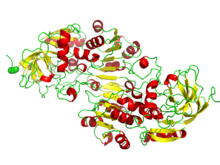This article is missing information about more non-nucleotide functions. (February 2021) |
| NAD(P)-binding Rossmann fold | |
|---|---|
| Identifiers | |
| Symbol | NADP_Rossmann |
| Pfam clan | CL0063 |
| ECOD | 2003.1 |
| Rossmann-like alpha/beta/alpha sandwich fold | |
|---|---|
 NAD/NADP binding rossmann fold domains. The picture depicts the beta-alpha folding in alcohol dehydrogenase. | |
| Identifiers | |
| Symbol | Rossmann-like_a/b/a_fold |
| Pfam clan | CL0039 |
| InterPro | IPR014729 |
The Rossmann fold is a tertiary fold found in proteins that bind nucleotides, such as enzyme cofactors FAD, NAD+, and NADP+. This fold is composed of alternating beta strands and alpha helical segments where the beta strands are hydrogen bonded to each other forming an extended beta sheet and the alpha helices surround both faces of the sheet to produce a three-layered sandwich. The classical Rossmann fold contains six beta strands whereas Rossmann-like folds, sometimes referred to as Rossmannoid folds, contain only five strands. The initial beta-alpha-beta (bab) fold is the most conserved segment of the Rossmann fold.[1] The motif is named after Michael Rossmann who first noticed this structural motif in the enzyme lactate dehydrogenase in 1970 and who later observed that this was a frequently occurring motif in nucleotide binding proteins.[2]
Rossmann and Rossmannoid fold proteins are extremely common. They make up 20% of proteins with known structures in the Protein Data Bank, and are found in more than 38% of KEGG metabolic pathways.[3] The fold is extremely versatile in that it can accommodate a wide range of ligands. They can function as metabolic enzymes, DNA/RNA binding, and regulatory proteins in addition to the traditional role.[4]
- ^ Hanukoglu I (2015). "Proteopedia: Rossmann fold: A beta-alpha-beta fold at dinucleotide binding sites". Biochemistry and Molecular Biology Education. 43 (3): 206–9. doi:10.1002/bmb.20849. PMID 25704928.
- ^ Cox MM, Nelson DL (2013). Lehninger Principles of Biochemistry (6th ed.). New York: W.H. Freeman. ISBN 978-1-4292-3414-6.
- ^ Cite error: The named reference
Medvedev_2019was invoked but never defined (see the help page). - ^ Cite error: The named reference
Medwas invoked but never defined (see the help page).